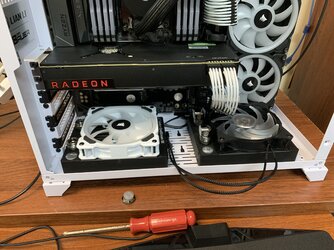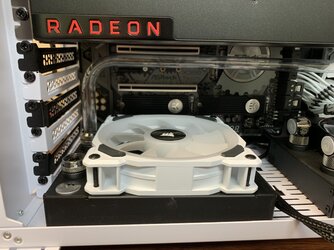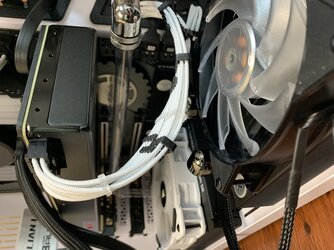-
Welcome to Overclockers Forums! Join us to reply in threads, receive reduced ads, and to customize your site experience!
You are using an out of date browser. It may not display this or other websites correctly.
You should upgrade or use an alternative browser.
You should upgrade or use an alternative browser.
Loop build thread
- Thread starter T56impala
- Start date
- Joined
- May 7, 2019
- Thread Starter
- #3
Purely aesthetics. Lots of space to fill in this case. I know it would likely have better efficiency if it were a single 240. Other than benchmarking, I doubt this system will every be pushed to maximum. The build is just an exercise/hobby for me. I’m learning something new.
- Joined
- Apr 19, 2012
Question, why are all the fans exhausting?
To exhaust the heat from the rads out of the case?
- Joined
- Aug 23, 2007
From my own experience w/ having 3 rads, having positive pressure (1 rad intake 2 exhaust adjusted by fan speed) makes a very large temperature difference. The PC needs to fresh air coming in so that you actually have some air to exhaust, otherwise you'll just have spinning fans that are struggling.
- Joined
- Apr 19, 2012
You want negative pressure?
No, Want lots of CFM flow. Debate over case pressures is wasted time.
You want to push in as much CFM as you can push out. (or pull).
Why go though the trouble of a custom loop and not optimize the airflow cooling your rads? 
I do not know much about water cooling but from what I've read, all fans on exhaust is not optimal, no matter the cooling method. Someone educate me otherwise please.
I do not know much about water cooling but from what I've read, all fans on exhaust is not optimal, no matter the cooling method. Someone educate me otherwise please.
- Joined
- Apr 19, 2012
Why go though the trouble of a custom loop and not optimize the airflow cooling your rads?
I do not know much about water cooling but from what I've read, all fans on exhaust is not optimal, no matter the cooling method. Someone educate me otherwise please.
I wasn't aware the case only held four fans. I'm assuming it holds at least double that. I don't see the top front or rear fans set up yet.....
- Joined
- May 7, 2019
- Thread Starter
- #11
Slow down guys. As mentioned above, the fans pictured were in for mock-up. I will be using 5 LL120s. Top three, mounted to the 360, will be intake. The bottom 2 mounted to the 120 rads will be exhaust. Along with the open holes on the bottom and back, I’m pretty sure it will get good airflow. If for some reason it doesn’t, I can add some 40mm or 80mm to the case. I don’t think they’ll be needed though.
- - - Auto-Merged Double Post - - -

Ignore all the fittings. Just there as a visual reference for me.
- - - Auto-Merged Double Post - - -
Okay, why does it keep posting multiples of the pictures???
- - - Auto-Merged Double Post - - -
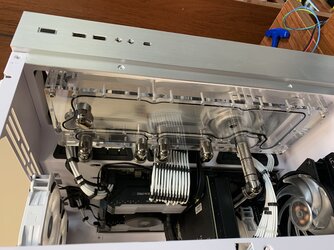
Ignore all the fittings. Just there as a visual reference for me.
- - - Auto-Merged Double Post - - -
Okay, why does it keep posting multiples of the pictures???
- Joined
- Apr 2, 2012
I wasn't aware the case only held four fans. I'm assuming it holds at least double that. I don't see the top front or rear fans set up yet.....
I have seen other pictures on his topic here, and top fans where exhausting and he's going with a res/distro block that covers all the front area (in this case actually he is putting it on the back/side drive bays area since the front doesn't appear to have mounting holes and its closed), so that is why i made the question.
But the user already explain it's a mock up and he plans top rad intake, but i still would prefer to have the bottom fans in pull config and the top in push, just because hot air naturally goes up.
Last edited:
- Joined
- Aug 23, 2007
That will "work" but blowing hot air out from the bottom will basically have the heat rise up the sides of the case and then get sucked back in from the top due to heat just rising. Granted in a forum for overclockers we are just looking at efficiency here so we are pointing out things that would make only a couple of degrees difference in cooling but there would be a difference. It's the same thing as "loop order doesn't matter" as that's somewhat true but where the rads are exhausting the heat does matter a great deal hence "loop order does somewhat matter"
In the end your loop will work just fine for anything you throw at it, we are just being bean counters lol. Looks good!
In the end your loop will work just fine for anything you throw at it, we are just being bean counters lol. Looks good!
Why not? There really is little difference in most cases. Positive keeps some dust from coming through the cracks, but otherwise, in my cases and experience of the last decade, I preferred more CFM exhaust than intake (though barely).You want negative pressure?
Cases are not pressurized (they are not sealed), it is just airflow.
Unless that one intake is a monster of CFM, you likely have just described NEGATIVE pressure or more CFM exhaust than intake.From my own experience w/ having 3 rads, having positive pressure (1 rad intake 2 exhaust adjusted by fan speed) makes a very large temperature difference. The PC needs to fresh air coming in so that you actually have some air to exhaust, otherwise you'll just have spinning fans that are struggling.
This!!!But the user already explain it's a mock up and he plans top rad intake, but i still would prefer to have the bottom fans in pull (intake) config and the top in push (exhaust), just because hot air naturally goes up.
Anyway, to the OP - With your radiator locations I would stick with airFLOW... front/sides/bottom = intake, top/rear = exhaust.
Last edited:
- Joined
- Aug 23, 2007
Unless that one intake is a monster of CFM, you likely have just described NEGATIVE pressure or more CFM exhaust than intake.
My front 360 60mm rad is in push pull set to a higher rpm than my 2 exhausting rads giving me positive pressure. This is confirmed by using smoke around the case. In doing so for my case at least having positive pressure dropped my temps by roughly 3°C. Having negative pressure I could even physically feel a reduction in airflow from my exhausting rads even when they spun faster.
- Joined
- Apr 19, 2012
Why do you insist on claiming positive case pressure. Such wasted conversations here.....
Let me show you how it's done. Not with no tiny rad fans. That's a joke.
I love cooling experiments. There's not much I haven't tried yet....
15, 000 cubic feet per minute.
Pardon this old picture. Probably 8-10 years ago.

What was that about rear exhaust fans spinning faster? The one in this picture is unplugged and is creating electricity and lighting it'self up under positive case pressure.
LOL, sorry OP. Build looks great so far. Don't mean to side track your thread. We need not debate peoples case pressure ideas, when it's not really a realistic conversation over un-measurable amounts of so call pressure in unsealed cases.
- - - Auto-Merged Double Post - - -
Anything dumping heat needs to dump out of the case. No point in dissipating radiator heat into the case.
Fresh cold air intake rad-less fans is the way to go for fresh air.
Let me show you how it's done. Not with no tiny rad fans. That's a joke.
I love cooling experiments. There's not much I haven't tried yet....
15, 000 cubic feet per minute.
Pardon this old picture. Probably 8-10 years ago.
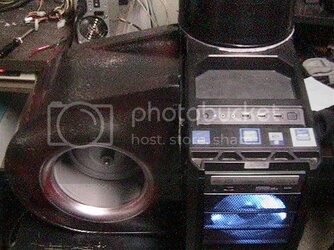
What was that about rear exhaust fans spinning faster? The one in this picture is unplugged and is creating electricity and lighting it'self up under positive case pressure.
LOL, sorry OP. Build looks great so far. Don't mean to side track your thread. We need not debate peoples case pressure ideas, when it's not really a realistic conversation over un-measurable amounts of so call pressure in unsealed cases.
- - - Auto-Merged Double Post - - -
I have seen other pictures on his topic here, and top fans where exhausting and he's going with a res/distro block that covers all the front area (in this case actually he is putting it on the back/side drive bays area since the front doesn't appear to have mounting holes and its closed), so that is why i made the question.
But the user already explain it's a mock up and he plans top rad intake, but i still would prefer to have the bottom fans in pull config and the top in push, just because hot air naturally goes up.
Anything dumping heat needs to dump out of the case. No point in dissipating radiator heat into the case.
Fresh cold air intake rad-less fans is the way to go for fresh air.
- Joined
- Apr 2, 2012
Fresh cold air intake rad-less fans is the way to go for fresh air.
I agree with this, although that's not always possible due to number of rads, case layout itself etc... In the pictures he posted he had 0 fans as intake so that's why i asked dude, because if you're are relying only on the case openings to get air inside, the fans trying to exhaust might "suffocate".
I'm not trying to get the user to go in any direction, i was just trying to help/understand why or if he did it by mistake. Hope i can make myself clear, sorry for the derail i started.
- Joined
- May 7, 2019
- Thread Starter
- #18
i did a little more work. Well, mostly failures in bending. I’m rethinking a few things and have already spent WAY more on the cooling than anticipated. Oh well. Part of learning with only videos and pictures as my guide. For reasons I can’t explain, I’ve decided to use flexible tubing for the cpu. Partly because I’m hoping AMD is hiding the next threadripper and will announce it later than the next gen chip. I’d like to be able to swap in the next one efficiently and without draining the loop.

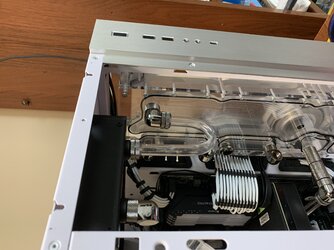
Attachments
Last edited:
- Joined
- Apr 19, 2012
No way you're doing a great job. If only we could count the mistakes... lol. Learning is best when hands on. Videos and pictures only go so far.
I really like the white and black colors with the chrome fittings.
@godevskii, It's a good catch to see the fans in the older config all pushing out. Essentially if the open case venting areas are placed well enough, you could create a flow of air that would suit the needs.
Really with the amount of radiators he has, probably won't have the need to really ramp the fans up unless under extended periods of time with heavy usage.
I really like the white and black colors with the chrome fittings.
@godevskii, It's a good catch to see the fans in the older config all pushing out. Essentially if the open case venting areas are placed well enough, you could create a flow of air that would suit the needs.
Really with the amount of radiators he has, probably won't have the need to really ramp the fans up unless under extended periods of time with heavy usage.
- Joined
- Jun 21, 2002
Looking Amazing! I really like that U shaped bend from the rad to the res, very clever solution to that awkward spot! I agree not to worry much about positive/negative pressures.
While I haven't done any formal incense burning (something still seems wrong about sending smoke into my PC), tissue tests have demonstrated that in this case the GPU semi-isolates the top and bottom fans. Thus with bottom intake and top exhaust, the bottom will be positive pressure (exhausting from the PCIe brackets), while the top will be negative pressure (drawing from the vents next to the IO port). I still need to do some experimentation as the rear of my case is currently approx 3 inches from a wall, and at high CFM I believe a significant amount of warm air is recirculated from the bottom portion and the PSU into the top. Not that that would really be any different from just having it flow through the case I guess. I actually considered experimenting with a top intake and bottom exhaust, however the filter would not fit between the top panel and the mount once the radiator was in place, due to the screws.
My greater concern is if you intend to water cool the GPU. If you leave it with the stock cooler, you absolutely will want to intake from the bottom in order to feed the GPU's cooler.
Are those 140mm rads on the bottom? Also a nice effect is that you can still see the diagnostic code output. That's something that always bothered me about the idea of adding a bottom rad.
While I haven't done any formal incense burning (something still seems wrong about sending smoke into my PC), tissue tests have demonstrated that in this case the GPU semi-isolates the top and bottom fans. Thus with bottom intake and top exhaust, the bottom will be positive pressure (exhausting from the PCIe brackets), while the top will be negative pressure (drawing from the vents next to the IO port). I still need to do some experimentation as the rear of my case is currently approx 3 inches from a wall, and at high CFM I believe a significant amount of warm air is recirculated from the bottom portion and the PSU into the top. Not that that would really be any different from just having it flow through the case I guess. I actually considered experimenting with a top intake and bottom exhaust, however the filter would not fit between the top panel and the mount once the radiator was in place, due to the screws.
My greater concern is if you intend to water cool the GPU. If you leave it with the stock cooler, you absolutely will want to intake from the bottom in order to feed the GPU's cooler.
Are those 140mm rads on the bottom? Also a nice effect is that you can still see the diagnostic code output. That's something that always bothered me about the idea of adding a bottom rad.
Similar threads
- Replies
- 2
- Views
- 635
